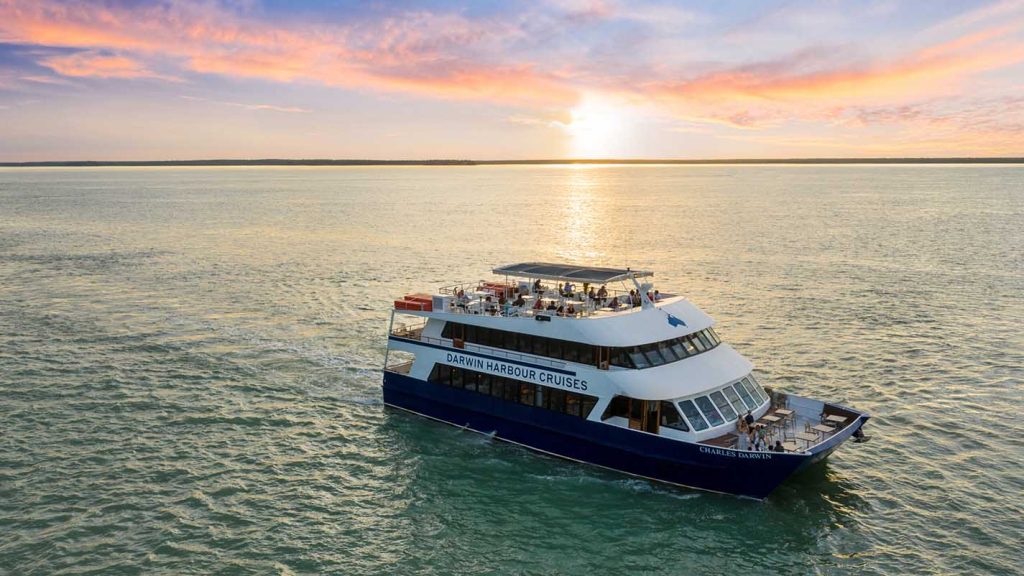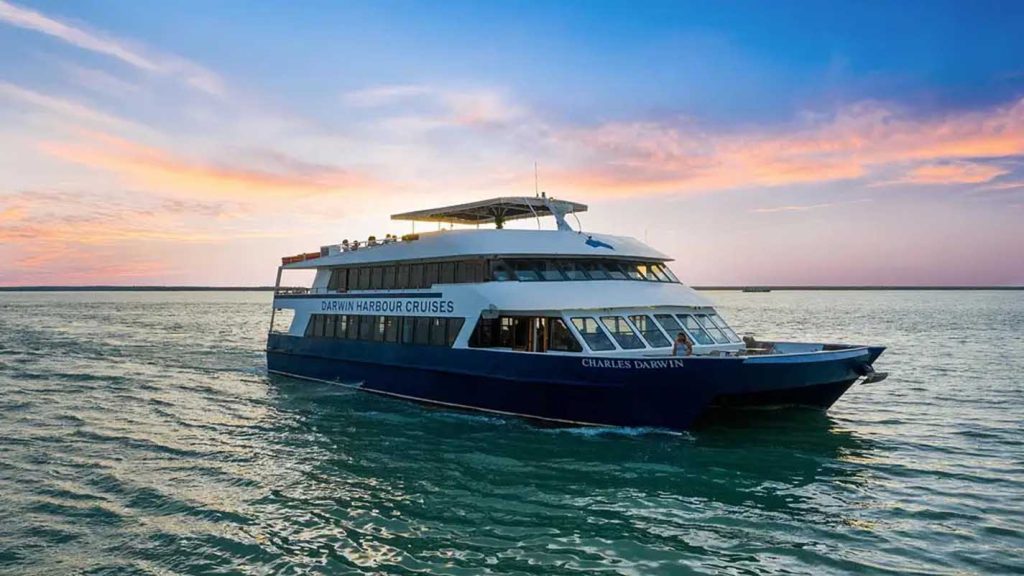1. Arrival in the Northern Capital
The sun climbed gently over the flat, red terrain as the plane banked toward the runway. Darwin’s silhouette approached with a quiet kind of authority—low, sun-washed buildings bordered by groves of palms and swathes of mangroves, stitched together by narrow roads leading to an ever-changing waterfront. As the door of the aircraft opened, the heat greeted me first—thick and unrelenting, not oppressive but present, like a constant reminder that I had arrived somewhere wholly different.
At the taxi stand, I exchanged a few words with a driver whose skin bore the sun’s long memory. We took off through the city with the sea occasionally flashing its silver-blue through gaps between buildings. The harbor was always in sight, always near, even when it wasn’t directly visible. Its presence gave Darwin an openness that felt as though the land was in constant conversation with the water.
I checked into my accommodation near the Esplanade and stepped onto the balcony. Below, the city rustled in a slow rhythm. Locals moved without hurry, like people who understood that the day could not be rushed, nor the ocean commanded.
2. To the Docks: The Journey Begins
Darwin’s harbor is the kind of place where movement comes with intention. When I arrived at the Stokes Hill Wharf, it was late afternoon. The tide was out, revealing mudflats dotted with fiddler crabs scuttling in feverish formation. Ferries and tour boats swayed against the moorings. A few people waited at the edge, leaning against the railings with fish and chips in hand, watching the water for signs of turtles or stingrays. It was the kind of harbor that didn’t need to dazzle to impress—it only had to exist.
I boarded the vessel for the harbor cruise. It was a low-slung, double-decked boat with long windows and open-air seating. Crew members moved about with quiet efficiency. There was no unnecessary showmanship, no scripted charm. Instead, the welcome felt sincere, practical, and rooted in the understanding that the real experience would be in watching the harbor unfold.
The boat pushed away from the dock, and a slow vibration began to hum beneath my feet. The shoreline slipped away, and the vastness of the harbor opened up.
3. Looking Seaward: The Shifting Blues of Darwin Harbour

As the boat picked up speed, the city began to blur into a collection of silhouettes. Behind me, the skyline—such as it was—stood in modest contrast against a golden sky. Ahead, the water shimmered in hundreds of hues, changing from greenish jade to gunmetal gray, to deep Pacific blue, and back again. The ocean in Darwin doesn’t stay still in its color or texture. It dances in response to the clouds, the tides, the angle of the sun.
The water here is vast. At times, it felt like the vessel was adrift on an inland sea rather than in a coastal bay. The harbor stretches so widely that one could believe the far shore to be a different world entirely. Yet that openness is part of its magic. Every glance out to sea suggested something new: a cargo ship slicing through the horizon, a patrol boat stationed idly near the edge of visibility, seabirds drifting effortlessly overhead.
We moved past Frances Bay, its quiet piers lined with weathered fishing trawlers. Their hulls bore scratches and rust stains from years of labor. Nets hung from masts like heavy curtains, and in the fading light, they looked almost theatrical, like props awaiting actors.
4. Looking Landward: A City Built on Resilience
Turning my gaze toward the land, Darwin unfolded as a city of quiet stories. It’s not the kind of place that leaps into a postcard-perfect image. Its appeal is layered. You have to look carefully.
As the cruise circled closer to the shoreline near Larrakeyah and Cullen Bay, I began to trace the city’s rhythm. Apartment blocks with generous balconies overlooked the sea; palms rustled over rooftop pools. Locals walked dogs along the edge of the cliffs, their silhouettes small against the pastel sky.
Darwin’s architecture is practical, designed for weather and wear, but occasionally a colonial veranda or a modern glass-fronted complex would stand out. War memorials peeked through the trees, and long disused gun emplacements sat in silence on the heights, remnants of the city’s role in World War II.
There’s a sense of layered time here. A building might stand beside a tropical tree older than the neighborhood itself. The smooth curves of modern design meet the rough edges of history.
5. Watching the People: Movement, Stillness, and Familiar Strangers
Aboard the cruise, people settled into their own rhythms. A group of European backpackers clustered near the rail, pointing at the coast and chatting quietly in German. A couple from Brisbane sat hand in hand, heads touching occasionally as they whispered. A man in a wide hat leaned back and closed his eyes completely, arms resting on the back of the bench like he was home.
I moved along the deck slowly, stopping near a group of older travelers sharing drinks. One of them gestured toward a patch of water and began recounting a tale of cyclone Tracy, pointing out where buildings once stood, how the sea swallowed whole suburbs. He spoke not like a guide, but like someone who had lived it, whose memory was anchored to these waters.
Further back, a crew member explained to a young boy how the tides in Darwin could rise and fall by more than 7 meters. The boy’s eyes grew wide. He looked at the water like it might rise right then and there.
There is something deeply human about watching others watch. The harbor became a mirror—reflecting how people encountered beauty, processed history, and shaped memory. Every quiet glance outward was also a glance inward.
6. The Pulse of the City: Sound, Light, and Motion

As the cruise veered toward East Point, the sun began to lower itself with almost theatrical timing. The sky ignited into pinks and oranges, and the water reflected the scene like a calm mind taking in a vivid dream. The light changed rapidly. Buildings turned into shadows. Trees became silhouettes. The harbor, once energetic and fluid, began to quiet.
Yet Darwin didn’t sleep. From the distance came the low thump of music from a waterfront bar, the call of a cockatoo, the thrum of a distant helicopter. Light spilled from hotels, restaurants, street lamps. The city hummed with evening energy.
Closer to the Esplanade, I could see couples walking hand in hand. A boy on a scooter traced loops along the path. A busker played acoustic guitar near Bicentennial Park, his chords carried faintly across the water. Darwin was not a place of noise, but of presence. It didn’t shout—it resonated.
7. Return to Shore: Reflection in Motion
The cruise slowly curled back toward Stokes Hill Wharf. The journey had taken a couple of hours, yet time had felt diffused, stretched thin across the horizon. The city was familiar again, but now richer. Buildings I had walked past earlier now had stories layered atop them—visual memories from a waterborne perspective.
As the boat slid into its mooring, the light was gone. In its place, warm artificial glows lit the gangway. Passengers filed off slowly, as though reluctant to leave. Some spoke softly, others walked silently. The quiet wasn’t solemn—it was contemplative.
I stepped onto the wharf and stood for a moment. The boat rocked gently behind me. Somewhere in the distance, the tide turned.
8. Twilight Wandering: Footsteps Through the Waterfront
Rather than head back immediately, I walked along the waterfront promenade. The air had cooled slightly, and the evening breeze was tinged with salt. Palm trees lined the path like sentinels. Nearby, diners sat under parasols with plates of grilled barramundi and local prawns. Laughter echoed across the open plaza.
Further down, I came upon a group gathered near a projection screen playing archival footage of the city’s history—snippets of wartime Darwin, images of cyclone Tracy, Aboriginal elders speaking in native tongues. Tourists and locals alike paused, watching as if seeking context for what they had seen from the water.
There was no rush. The harbor had a way of slowing everything down. Even in movement, it instilled a sense of patience.
9. Late Night Over the Water
Eventually, I returned to the balcony of my accommodation. The harbor was no longer visible in detail, but its presence remained. The occasional light from a vessel winked in the distance. A gust of wind carried the scent of mangrove and seaweed. The cruise had ended hours ago, but the sensations still swirled—the rhythmic roll of the boat, the kaleidoscope of sea colors, the quiet humanity of faces watched in silhouette.
Darwin offers more than sights; it offers sensations. A harbor cruise here is not just a tour, not a tick-box item. It’s a passage—a way of experiencing a city through its most honest and open feature. The water doesn’t hide anything. It simply reflects what already is.